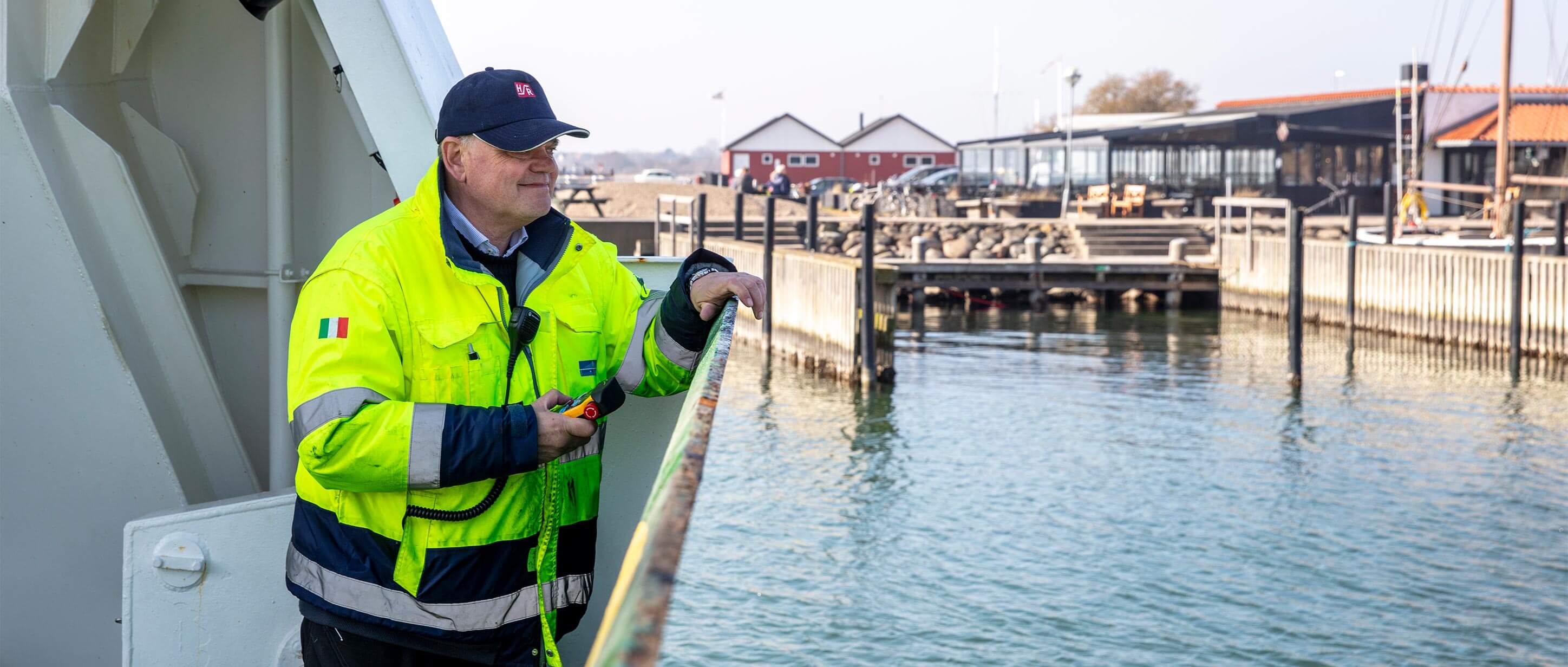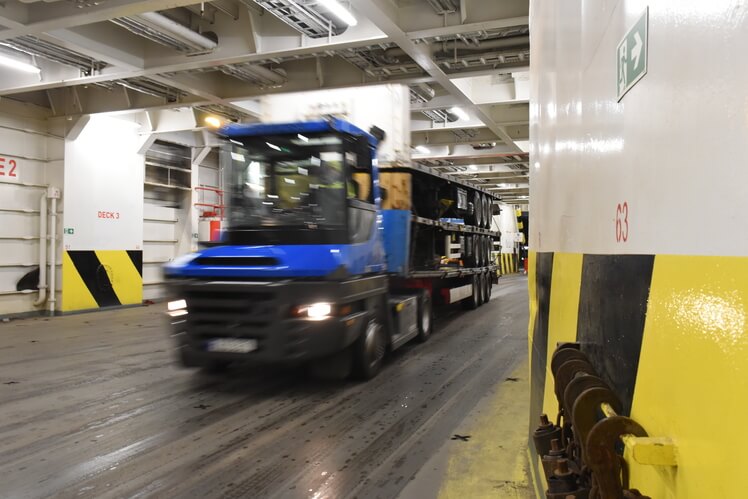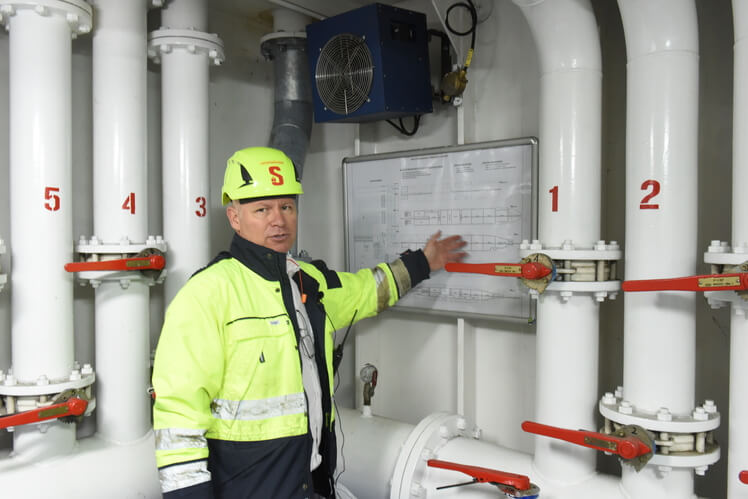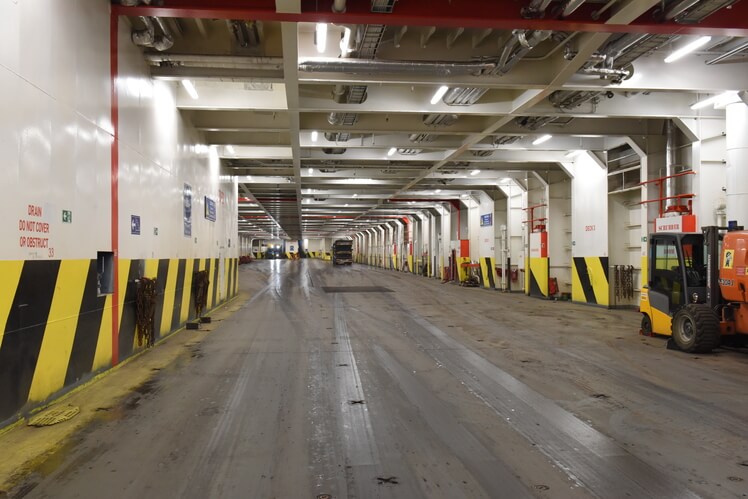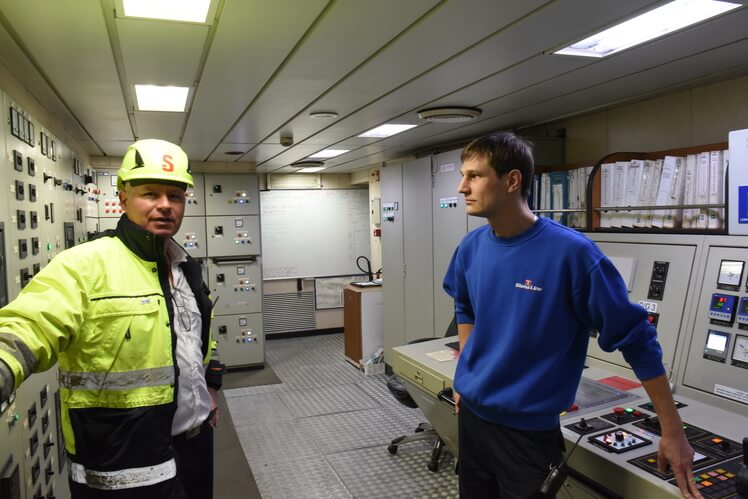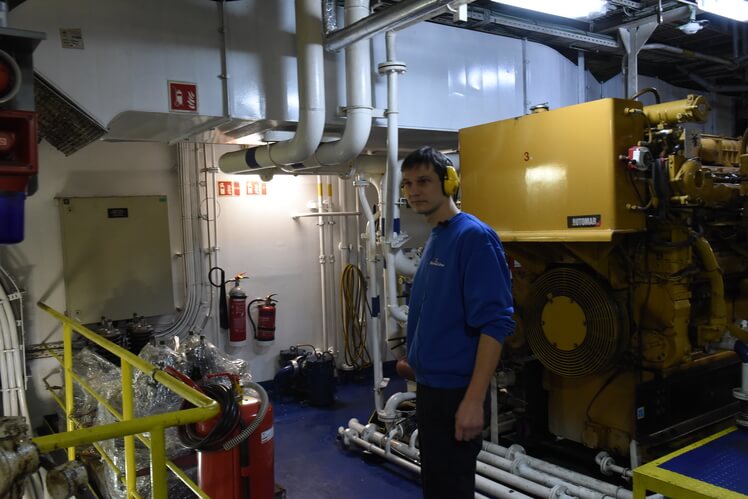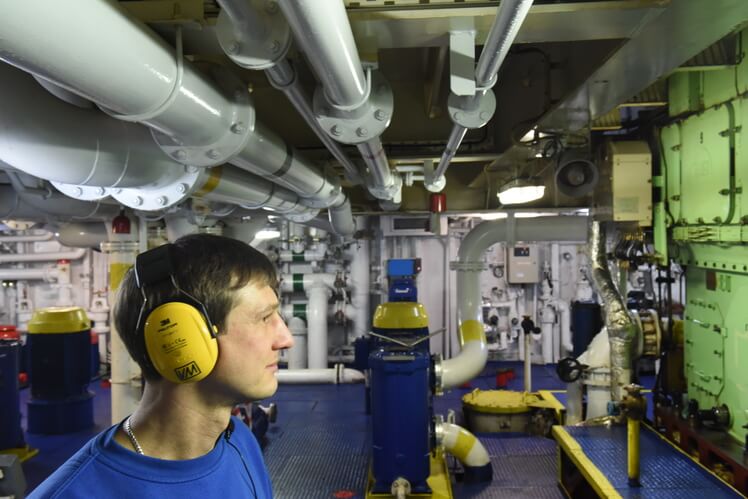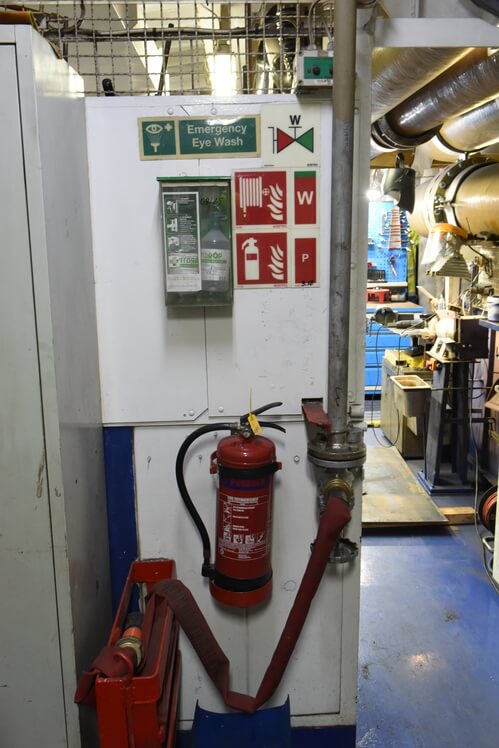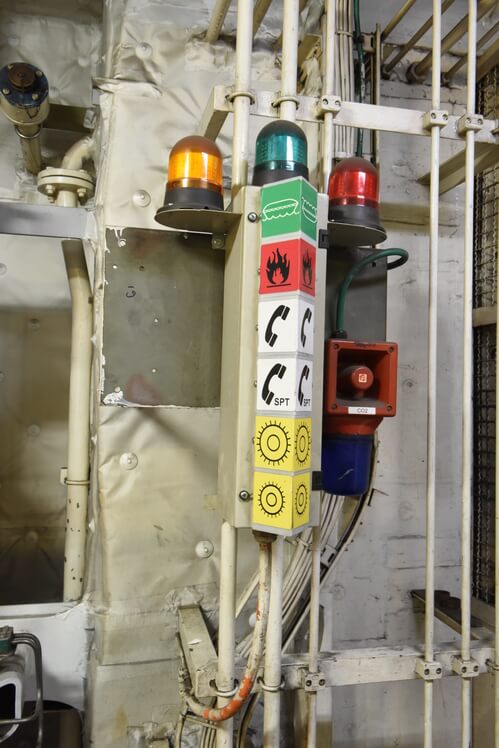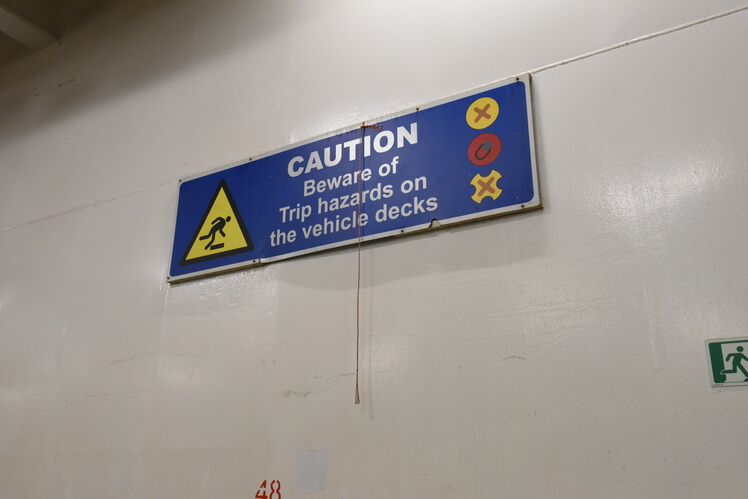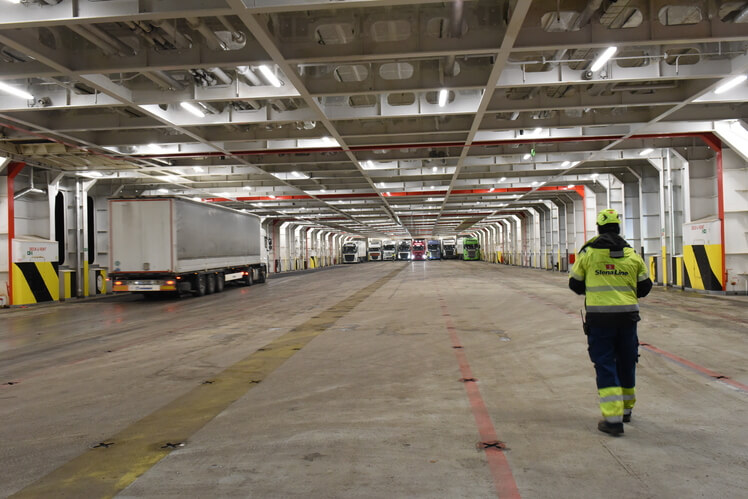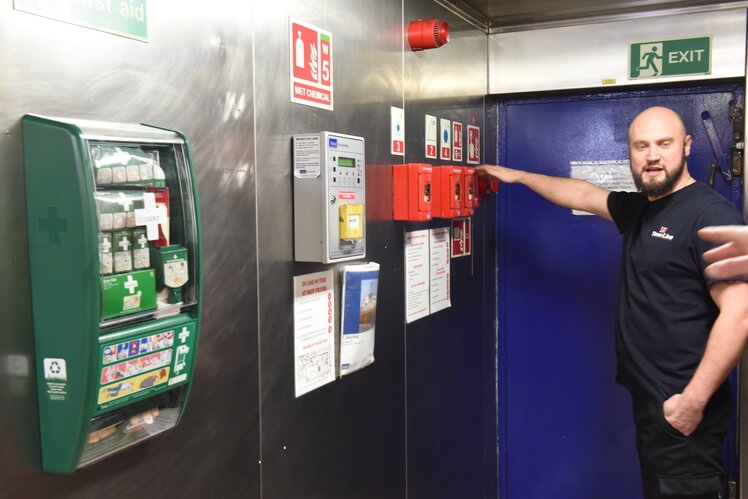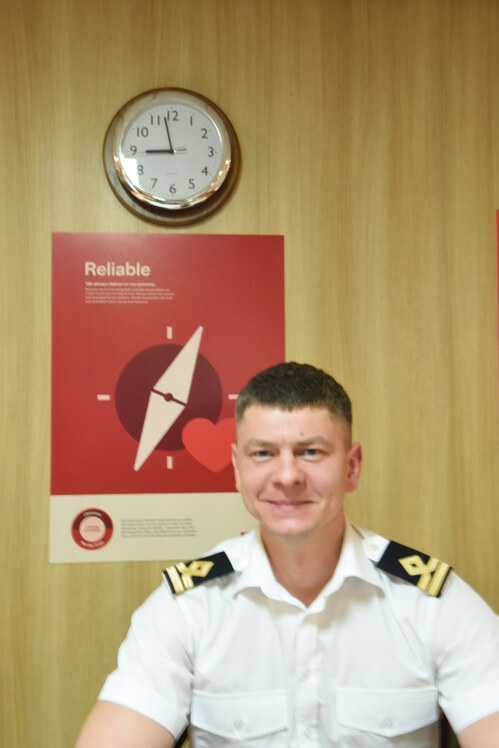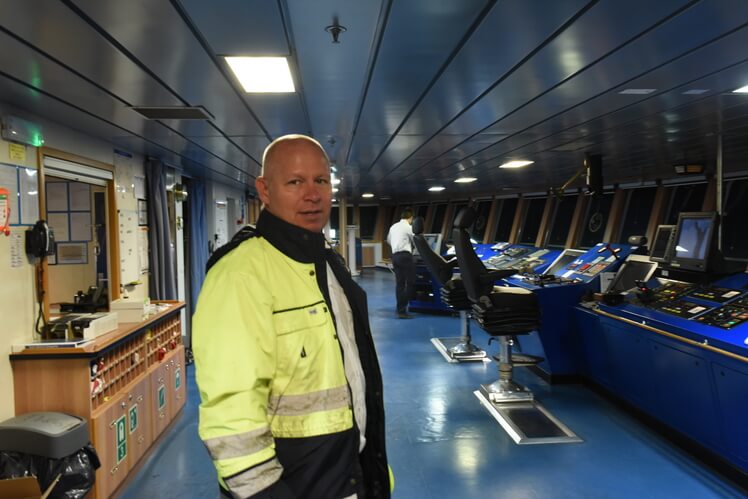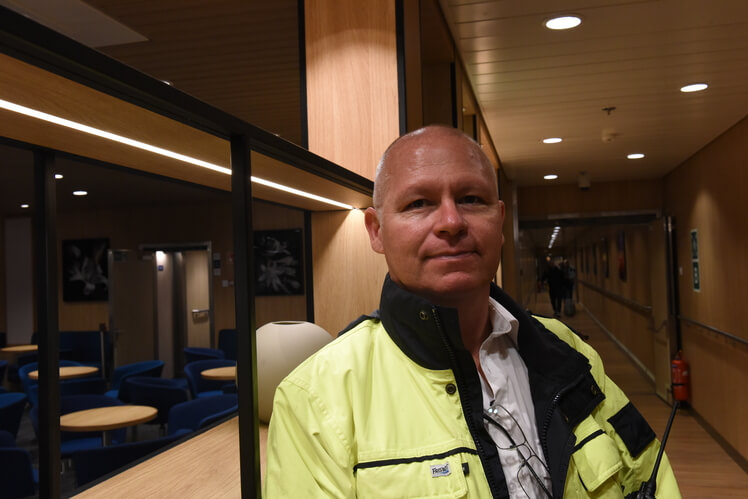Seniority is high at Stena Line. The employees stay with the shipping company for a long time, simply because it is a good place to be, says Christian Ragnvaldsson, captain of Stena Baltica. This fact is reflected in the high level of safety on board, he points out, because safety is about the people who create it.
This time it's dark. And seriously chilly. The temperature is thus not much above freezing, and UFDS is in Nynäshamn south of Stockholm, where RoPax ferry Stena Baltica commutes to and from Ventspils in Latvia on the other side of the Baltic Sea.
On a Tuesday evening in mid-January, Captain Christian Ragnvaldsson has invited to a visit for a talk about – and showcase of – the safety measures Stena Line is operating on its ferries, just as DFDS and ForSea have previously told about their initiatives and programs.
And just as it is the case for the other shipping companies, safety for Stena Line is a matter with which work is done very thoroughly and systematically through extensive checklists, frequent drills and several scheduled procedures, just as everything in terms of hardware and equipment is of course top notch.
But when UFDS asks Captain Ragnvaldsson what safety really means to him as the commanding officer of the ship, his starting point is quite different.
»Safety is everything in everyday life. If something happens, we must be able to have faith that security works, that we have a good organization, that we have a competent staff, that our equipment and systems functions. And especially for me as a captain, I have to be able to sense it, because otherwise I would be nervous all the time. But I am very relaxed because I trust my crew and that everything is checked through,« the experienced sailor with about 27 years in Stena Line behind him says.
Furthermore, he says, working proactively with safety is a constant issue, both locally on the ship and in the company as a whole. This is done, among other things, by investing in the very employees mentioned by Christian Ragnvaldsson through their employment conditions.
»We want the same staff coming back to the same ship. If you come here on a short contract, then you are not properly motivated for your work when you are not going back. The people we have on board here, they see this ship as their second home – they are often more on board than they are at home,« he says.
The equation is relatively simple, he believes: The more time people are on board, the more experience they build, the more professional they become and – not least – the more understanding they get of how important safety is.
People rarely leave Stena Line
Stena Baltica was born as the Mersey Viking at an Italian shipyard in 2005 and has since then sailed under three different names – Stena Mersey since 2011 – on the route between Belfast in Northern Ireland and the Liverpool suburb of Birkenhead in England until January 2021.
Since then, she underwent a major rebuilding in Turkey, including the addition of a 36-metre-long mid-section, which brought the vessel's total length to the current 222 metres, before she was renamed and deployed on her current route between Sweden and Latvia at the end of 2021.
For Christian Ragnvaldsson and his crew, which on today's departure counts 58 men for about 300 passengers out of a max capacity of just under 1,000, their workplace is still fairly new. This does not however mean that they are also new to the shipping company or, for that matter, the labor market.
»We've only been at it on this vessel for a year, but we haven't had any serious accidents that have led to lost working hours yet. And this is very much down to the experience of the people from their time in the shipping company,« he says and continues:
»It's actually quite rare for people to leave Stena Line. Of course, they can switch between different ships as part of their careers, or move to other offices, but otherwise it almost never happens, especially among us on deck, that people find brand new jobs.«
According to the captain, this is also one of the pillars of good security, because you don’t have to continuously rebuild culture and knowledge in the area as the crew is replaced.
Seniority and job satisfaction are thus generally high in Stena Line, and clearly also something that is close to Christian Ragnvaldsson's heart on a daily basis, where he very consciously prioritizes not only a safe working environment, but also a friendly tone and a relaxed climate on board.
»I know it's going well when people walk out of the mess with a smile on their face. People have to be on their toes in a good way, for example on the car deck, and it’s no good if an officer has stood and shouted at them, because then they are not clear in the heads. So, we need to treat people properly, make sure they get paid, good food, good cabins, rest time and so on, so they can focus on working safely,« he says.
»Good security starts with the human being. You can have good systems and automatic solutions that can handle everything, but if they fail, then it's up to the human to save the day. And a motivated and happy crew will do just that,« he adds.
Privileged to have a dedicated safety officer
Stena Line has prepared plans for musters and drills for all its vessels, including of course Stena Baltica, which therefore conducts various trainings at regular intervals. On a weekly basis, this applies, for example, to evacuations, fire drills and lowering of lifeboats, and at slightly longer intervals launching the fast rescue boat and training enclosed space entry.
One of the newest exercises in the plan concerns cyber security, which will be attended to on an annual basis in the future. Both in Denmark and in the Nordic region in general, there has thus been an increase in the number of more or less unexplained incidents, where, for example, GPS signals disappear and ships are left sailing in the blind – if sailing at all.
Incidents of this kind is taken are very seriously among shipping companies, and for the same reason, Christian Ragnvaldsson and a number of his high ranking colleagues were on a five-day course in Glasgow in November 2022, where scenarios with GPS disturbances in various simulations were run.
»It was both exciting and a little fun, but also thought-provoking to see the boat jump around on the radar screen in this way, so you had no idea where you were. And that's something we have to deal with in the future, no doubt about it,« he said.
At this point in the conversation, we are joined by Andrei Aleinikov, Safety Officer at Stena Baltica, and thus the man with the in-depth knowledge of safety on board. Unlike what you can experience on other vessels, where the security officer is in some cases also the 1st officer, Andrej solely deals with the safety of the ship, emphasizes Christian Ragnvaldsson.
»I make my rounds every day looking for bugs or other things related to security. My most important task I see as explaining to the crew that safety is first and foremost important to themselves, that they must take care of each other, and I think I have achieved that goal in the past year. People are doing well and are happy to be here,« says Aleinikov.
Christian Ragnvaldsson acknowledges this statement without hesitation and talks about how he senses the atmosphere among the crew on board. The danger signal is only if he enters a room, and no one’s talking to each other or making eye contact with him.
»It's a privilege to have a dedicated safety officer, and you can also see that in our accident statistics, so it's something we really appreciate,« he underlines.
Looking forward to shore power
But as returning readers will know, the visit is not all talk, so as was the case on Princess Seaways and Aurora of Helsingborg, UFDS also gets an extensive tour of Stena Baltica, while she is being prepared for departure on the trip to Latvia. The crossing only takes eight hours, so there is one departure every day in both directions.
The tour starts in the engine control room, where chief engineer Viktors Martinovs, who like a large part of the rest of the crew is from Latvia, greets with an introduction to the propulsion systems and the other installations in the engine room of the 26,500 gross ton ferry.
This consists of two main engines from MAN B&W and three auxiliary engines, in addition to diesel generators, ballast water systems, electrical installations and much more. There are great forces at play, as Christian Ragnvaldsson mentions several times on the tour, of which the people in the engine are very aware.
»Right now it’s quiet, but when we go to sea and out into the waves, everything starts rolling (it was some stormy days in the Baltic Sea when UFDS was visiting, ed.), and then of course we are extra careful when we move around down here,« says Viktors Martinovs, who has been with the shipping company for 13 years.
The trip into the engine itself starts via a waterproof door that creeps open at as the noise level – a work hazard in itself, so of course everyone is wearing hearing protection – increases considerably. As we move around, Viktors points to well-known measures such as clear markings, fire extinguishers, warning systems and the ubiquitous sprinklers.
»We have a lot of respect for fire, so our equipment to fight fires is very modern, and we hold a lot of drills to be ready in case something happens,« he says through the noise.
In terms of noise, and for that matter also the air quality in the engine and outside the ship, many players in the ferry industry as a whole are looking forward to 2025 when it will be mandatory for ships on a regular route to connect to (green) shore power while in port, allowing them to turn off the on board generators.
Stena Baltica is currently establishing its own plug and reception system for the massive cable – the diameter is almost like a handball – that will connect the ship to the shore installation, and on behalf of the environment, this is something Christian Ragnvaldsson is looking forward to.
Proud of the crew
We are now moving onto the car deck, which is notoriously one of the riskiest places to work on a ferry with rolling goods. The small tractors moving truck trailers on board are fast, so the rule of thumb is to always wear high visibility clothing, and quite simply to watch your step.
»We have five cargo decks, so that’s a lot of cargo in and out while we're in port, and these units weigh between 30 and 50 tons each. So you have to be awake, not walking around staring down at your phone or anything like that,« the captain says in a somewhat commanding tone.
We will also pass by the compartment from where which the aforementioned sprinklers must be activated in case of fire. It is deliberately a string of very analog valves that must be physically turned by hand, as according to Christian Ragnvaldsson, it is important to be able to see and hear clearly that the water lines are open, rather than having to rely on a digital solution.
The trip to the as yet half-empty middle car deck offers a steep walk up the internal ramp, where Christian Ragnvaldsson points to the non-slip surface that is applied both in the lanes themselves and at the edge where we walk.
The middle deck has several metre-high and wide openings on both sides, which is fine for air quality, but mostly concerns the fact that this allows for the vessel to transport several types of dangerous goods. To the captain's satisfaction, however, this is not particularly common on the route.
We walk back down the ramp and through the passenger access on the lower car deck, from where something as relatively unusual on this kind of ferries as an escalator takes us up to the cabins, lounge areas, the restaurant and the recently converted SeaShop with duty free goods.
Here, various risks are generally not abundant, but the galley is a classic risk zone with hot pots, pans, cooking oil and so on, as head chef Alexei Sergeyev points to along with more fire equipment, including CO2 extinguishers in the storage compartment, and other devices to protect people, not least when the ship rolls in high seas.
Out on deck, Christian Ragnvaldsson displays a selection of the lifeboats at Stena Baltica, where a deliberately significant overcapacity is employed. In total, the ship's various life rafts can handle around 1,300 people, although the maximum passenger capacity (plus up to 100 crew) is rarely in play.
The inflatable rafts must be activated every 6 years, and the next time is actually in early February, which the captain is looking forward to.
»For this we gather a lot of people in Latvia, including some from the head office, some of Vikings (the manufacturer, ed.) people from Estonia, the local coast guard and also the part of the crew that are otherwise off, and then we deploy the systems. Subsequently, everyone gets a certificate that is valid for five years,« says Ragnvaldsson.
A steel staircase later, we find ourselves on the bridge and the conclusion of the tour, which he uses to pick up on the core of his account of the good safety of the ship.
»Especially in the winter, when it's stormy and there's not much time for a turnaround, it's clear that we have a fantastic crew on board. They are motivated, they are safe, they do a great job and work superbly together, so I am very happy and proud of them,« says Ragnvaldsson.



